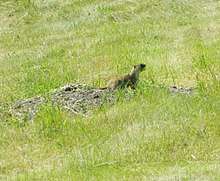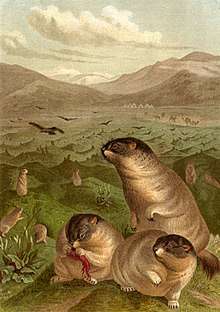Bobak marmot
| Bobak Marmot | |
|---|---|
 | |
| Regional Landscape Park «Dykanskyy» Ukraine | |
| Scientific classification | |
| Kingdom: | Animalia |
| Phylum: | Chordata |
| Class: | Mammalia |
| Order: | Rodentia |
| Family: | Sciuridae |
| Genus: | Marmota |
| Subgenus: | Marmota |
| Species: | M. bobak |
| Binomial name | |
| Marmota bobak (Müller, 1776) | |
 | |
| Bobak marmot range.[2] | |
The bobak marmot (Marmota bobak), also known as the steppe marmot, is a species of marmot that inhabits the steppes of Eastern Europe and Central Asia. It is a social animal and inhabits steppe grassland, including cultivated field borders. It hibernates for more than half the year. Litter sizes average about five offspring and it takes three years for the young marmots to reach sexual maturity. Male offspring leave the home colony after their second winter, and about 60% of mature females give birth in any one year. The fur is used to make hats and coats and a Moscow fur-farm is experimenting with breeding bobak marmots for their pelts.
Taxonomy
Subspecies:[3]
- M. b. bobak
- M. b. tschaganensis
Distribution
The bobak marmot is native to the steppes of Eastern Europe (primarily Ukraine and Russia) and Central Asia. It is also found in Belarus.[4] Thus, its range stretches from Eastern Europe to North and Central Kazakhstan,[3][5] and is particularly found between the Donets and Don rivers (Kharkiv and Luhansk Oblasts in Ukraine and neighbouring regions in Russia) and east to Kazakhstan.
Ecology
The bobak marmot is a large analog of the North American prairie dog, with a particularly round paunch and a laid-back alert posture. Unlike most other species, bobak marmots prosper on rolling grasslands and on the edge of cultivated fields. Active for about five and a half months each year, dispersers leave their natal social group after their second hibernation. Litter sizes average a little over five, and it takes at least three years to reach sexual maturity. About 60% of adult females breed in a given year. They have a single alarm call, but studies have demonstrated that bobak marmots call faster when they live in steep terrain and slower when they live in flatter terrain. Bobak marmots' fur is used to make hats and the occasional coat. Outside Moscow, a fur-farm is experimenting with breeding bobak marmots in captivity for captive fur production.
Like other marmots, the bobak is susceptible to infection by bubonic plague. A population of bobaks living in the Ural Mountains is believed to have served as a reservoir host for the bubonic plague epidemic that struck western Russia at the end of the 19th century.
Marmots are preyed upon by snow leopards. They can also act as a buffer against other prey of the snow leopard.[6]
Cultural trivia

The bobak marmot is a symbol of Luhansk Oblast, Ukraine, as is found on its coat of arms and on the coats of arms of some of its "raions" or districts.
See also
References
- ↑ Tsytsulina, K.; Zagorodynuk, I.; Formozov, N. & Sheftel, B. (2008). "Marmota bobak". IUCN Red List of Threatened Species. Version 2008. International Union for Conservation of Nature. Retrieved 6 January 2009.
- ↑ IUCN (International Union for Conservation of Nature) 2008. Marmota bobak. In: IUCN 2015. The IUCN Red List of Threatened Species. Version 2015.2. "Archived copy". Archived from the original on 2014-06-27. Retrieved 2006-05-11. . Downloaded on 10 July 2015.
- 1 2 Grubb, P. (2005). Wilson, D.E.; Reeder, D.M., eds. Mammal Species of the World: A Taxonomic and Geographic Reference (3rd ed.). Johns Hopkins University Press. ISBN 978-0-8018-8221-0. OCLC 62265494.
- ↑ Wilson, D. E. & Reeder, D. M. (editors). 2005. Mammal Species of the World. A Taxonomic and Geographic Reference (3rd ed).
- ↑ Tsytsulina, K., Zagorodnyuk, I., Formozov, N. & Sheftel, B. Marmota bobak in: IUCN 2010. IUCN Red List of Threatened Species. Version 2010.2
- ↑ Jackson, R.; Hunter, D. O. (1996). "Snow Leopard Survey and Conservation Handbook Part III" (PDF). Snow Leopard Survey and Conservation Handbook. Seattle, Washington, & Fort Collins Science Center, Colorado, the United States of America: International Snow Leopard Trust & U.S. Geological Survey. pp. 1–55. Retrieved 2009-03-14.
- Thorington, R. W. Jr. and R. S. Hoffman. 2005. Family Sciuridae. Pp. 754–818 in Mammal Species of the World a Taxonomic and Geographic Reference. D. E. Wilson and D. M. Reeder eds. Johns Hopkins University Press, Baltimore.
| Wikimedia Commons has media related to Bobak marmot. |
